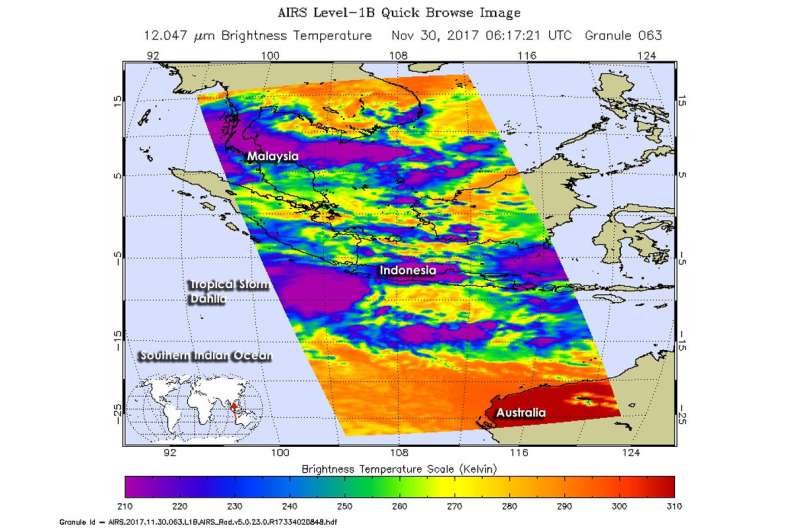NASA finds newly formed Tropical Storm Dahlia battling wind shear

Tropical Storm Dahlia formed under the conditions of vertical wind shear, which displaced the bulk of its clouds north of the center. Infrared imagery from NASA's Aqua satellite revealed that Tropical Storm Dahlia showed strongest thunderstorms north of its center of circulation as the storm moved through the Southern Indian Ocean.
NASA's Aqua satellite passed over Dahlia on Nov. 30 at 1:17 a.m. EST (0617 UTC) and analyzed the storm in infrared light. Infrared light provides temperature data and that's important when trying to understand how strong storms can be. The higher the cloud tops, the colder and the stronger they are.
AIRS data showed coldest cloud top temperatures in thunderstorms were being pushed north of the center. Those cloud top temperatures were as cold as minus 63 degrees Fahrenheit (minus 53 degrees Celsius). Storms with cloud top temperatures that cold have the capability to produce heavy rainfall.
On Nov. 30 at 11 a.m. EDT (1500 UTC) maximum sustained winds were near 45 knots (52 mph/83 kph) and Dahlia is forecast to strengthen slightly over the next two days before weakening. Dahlia was located near 9.6 degrees south latitude and 108.0 degrees east longitude. That's about 865 nautical miles north-northwest of Learmonth, Australia. Dahlia was moving to the east-southeast at 14 knots (16 mph/26 kph).
The Joint Typhoon Warning Center (JTWC) noted that "Animated enhanced Infrared satellite imagery depicts a consolidating low-level circulation center with improved convective banding, however, an image indicates the well-defined center is displaced along the southeast edge of the deep convection due to moderate east-northeasterly vertical wind shear.
The JTWC forecast calls for Dahlia to track southeastward over cooler sea surface temperatures and encounter increasing vertical wind shear associated with upper-level westerlies over northwest Australia. Those winds will weaken the system and lead to eventual dissipation as Dahlia approaches the Learmonth area.
Provided by NASA's Goddard Space Flight Center





















